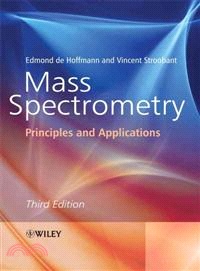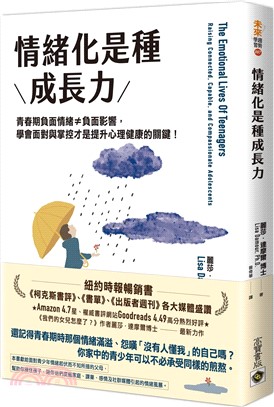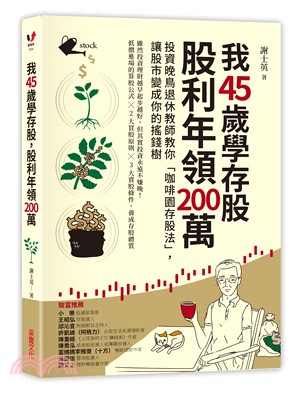Mass Spectrometry - Principles And Applications 3E
商品資訊
定價
:NT$ 7803 元優惠價
:90 折 7023 元
若需訂購本書,請電洽客服 02-25006600[分機130、131]。
相關商品
商品簡介
作者簡介
名人/編輯推薦
目次
商品簡介
The latest edition of a highly successful textbook, Mass Spectrometry, Third Edition provides students with a complete overview of the principles, theories and key applications of modern mass spectrometry. All instrumental aspects of mass spectrometry are clearly and concisely described: sources, analysers and detectors. Tandem mass spectrometry is introduced early on and then developed in more detail in a later chapter. Emphasis is placed throughout the text on optimal utilisation conditions. Various fragmentation patterns are described together with analytical information that derives from the mass spectra.
This new edition has been thoroughly revised and updated and has been redesigned to give the book a more contemporary look. As with previous editions it contains numerous examples, references and a series of exercises of increasing difficulty to encourage student understanding. Updates include: Increased coverage of MALDI and ESI, more detailed description of time of flight spectrometers, new material on isotope ratio mass spectrometry, and an expanded range of applications.
Mass Spectrometry, Third Edition is an invaluable resource for all undergraduate and postgraduate students using this technique in departments of chemistry, biochemistry, medicine, pharmacology, agriculture, material science and food science. It is also of interest for researchers looking for an overview of the latest techniques and developments.
This new edition has been thoroughly revised and updated and has been redesigned to give the book a more contemporary look. As with previous editions it contains numerous examples, references and a series of exercises of increasing difficulty to encourage student understanding. Updates include: Increased coverage of MALDI and ESI, more detailed description of time of flight spectrometers, new material on isotope ratio mass spectrometry, and an expanded range of applications.
Mass Spectrometry, Third Edition is an invaluable resource for all undergraduate and postgraduate students using this technique in departments of chemistry, biochemistry, medicine, pharmacology, agriculture, material science and food science. It is also of interest for researchers looking for an overview of the latest techniques and developments.
作者簡介
Edmond de Hoffmann
Universit´e Catholique de Louvain, Belgium & Ludwig Institute for
Cancer Research, Brussels, Belgium
Vincent Stroobant
Ludwig Institute for Cancer Research, Brussels, Belgium
Universit´e Catholique de Louvain, Belgium & Ludwig Institute for
Cancer Research, Brussels, Belgium
Vincent Stroobant
Ludwig Institute for Cancer Research, Brussels, Belgium
名人/編輯推薦
"An excellent source of qualitative information on MS for postgraduates and professionals in the fields of research … .A reasonably priced book and we would recommend it." (The Higher Education Academy Physical Sciences Centre, December 2008)
"Featuring numerous examples, references, and a series of exercises of increasing difficulty, this updated edition now includes additional coverage." (Materials and Corrosion, November 2007)
"Featuring numerous examples, references, and a series of exercises of increasing difficulty, this updated edition now includes additional coverage." (Materials and Corrosion, November 2007)
目次
Preface.
Introduction.
Principles.
Diagram of a Mass Spectrometer.
History.
Ion Free Path.
1 Ion Sources.
1.1 Electron Ionization.
1.2 Chemical Ionization.
1.2.1 Proton transfer.
1.2.2 Adduct formation.
1.2.3 Charge-transfer chemical ionization.
1.2.4 Reagent gas.
1.2.5 Negative ion formation.
1.2.6 Desorption chemical ionization (DCI).
1.3 Field Ionization.
1.4 Fast Atom Bombardment and Liquid Secondary Ion Mass Spectrometry.
1.5 Field Desorption.
1.6 Plasma Desorption.
1.7 Laser Desorption.
1.8 Matrix-Assisted Laser Desorption Ionization.
1.8.1 Principle of MALDI.
1.8.2 Practical considerations.
1.8.3 Fragmentations.
1.8.4 Atmospheric pressure matrix-assisted laser desorption ionization.
1.9 Thermospray.
1.10 Atmospheric Pressure Ionization.
1.11 Electrospray.
1.11.1 Multiply charged ions.
1.11.2 Electrochemistry and electric field as origins of multiply charged ions.
1.11.3 Sensitivity to concentration.
1.11.4 Limitation of ion current from the source by the electrochemical process.
1.11.5 Practical considerations.
1.12 Atmospheric Pressure Chemical Ionization.
1.13 Atmospheric Pressure Photoionization (APPI).
1.14 Atmospheric Pressure Secondary Ion Mass Spectrometry (APSIMS).
1.14.1 Desorption electrospray ionization (DESI).
1.14.2 Direct analysis in real time (DART).
1.15 Inorganic Ionization Sources.
1.15.1 Thermal ionization source.
1.15.2 Spark source.
1.15.3 Glow discharge source.
1.15.4 Inductively coupled plasma source.
1.15.5 Practical considerations.
1.16 Gas-Phase Ion-Molecule Reactions.
1.17 Formation and Fragmentation of Ions: Basic Rules.
1.17.1 Electron ionization and photoionization under vacuum.
1.17.2 Ionization at low pressure or at atmospheric pressure.
1.17.3 Proton transfer.
1.17.4 Adduct formation.
1.17.5 Formation of aggregates or clusters.
1.17.6 Reactions at the interface between source and analyzer.
2 Mass Analyzers.
2.1 Quadrupole Analyzers.
2.1.1 Description.
2.1.2 Equations of motion.
2.1.3 Ion guide and collision cell.
2.1.4 Spectrometers with several quadrupoles in tandem.
2.2 Ion Trap Analyzers.
2.2.1 Three-dimensional ion trap.
2.2.2 Two-dimensional ion trap.
2.3 The Electrostatic Trap or "Orbitrap".
2.4 Time-of-Flight Analyzers.
2.4.1 Linear time-of-flight mass spectrometer.
2.4.2 Delayed pulsed extraction.
2.4.3 Reflectrons.
2.4.4 Tandem mass spectrometry with time-of-flight analyzer.
2.4.5 Orthogonal acceleration time-of-flight instruments.
2.5 Magnetic and Electromagnetic Analyzers.
2.5.1 Action of the magnetic field.
2.5.2 Electrostatic field.
2.5.3 Dispersion and resolution.
2.5.4 Practical considerations.
2.5.5 Tandem mass spectrometry in electromagnetic analyzers.
2.6 Ion Cyclotron Resonance and Fourier Transform Mass Spectrometry.
2.6.1 General principle.
2.6.2 Ion cyclotron resonance.
2.6.3 Fourier transform mass spectrometry.
2.6.4 MSn in ICR/FTMS instruments.
2.7 Hybrid Instruments.
2.7.1 Electromagnetic analyzers coupled to quadrupoles or ion trap.
2.7.2 Ion trap analyzer combined with time-of-flight or ion cyclotron resonance.
2.7.3 Hybrids including a time-of-flight with orthogonal acceleration.
3 Detectors and Computers.
3.1 Detectors.
3.1.1 Photographic plate.
3.1.2 Faraday cup.
3.1.3 Electron multipliers.
3.1.4 Electro-optical ion detectors.
3.2 Computers.
3.2.1 Functions.
3.2.2 Instrumentation.
3.2.3 Data acquisition.
3.2.4 Data conversion.
3.2.5 Data reduction.
3.2.6 Library search.
4 Tandem Mass Spectrometry (MS/MS).
4.1 Tandem Mass Spectrometry in Space or in Time.
4.2 Tandem Mass Spectrometry Scan Modes.
4.3 Collision-activated or Collision-induced Dissociation (CAD or CID).
4.3.1 Collision energy conversion to internal energy.
4.3.2 High-energy collision (keV).
4.3.3 Low-energy collision (between 1 and 100 eV).
4.4 Other Methods of Ion Activation.
4.5 Reactions Studied in MS/MS.
4.6 Tandem Mass Spectrometry Applications.
4.6.1 Structure elucidation.
4.6.2 Selective detection of target compound class.
4.6.3 Ion–molecule reaction.
4.6.4 The kinetic method.
5 Mass Spectrometry/Chromatography Coupling.
5.1 Elution Chromatography Coupling Techniques.
5.1.1 Gas chromatography/mass spectrometry (GC/MS).
5.1.2 Liquid chromatography/mass spectrometry (LC/MS).
5.1.3 Capillary electrophoresis/mass spectrometry (CE/MS).
5.2 Chromatography Data Acquisition Modes.
5.3 Data Recording and Treatment.
5.3.1. Data recording.
5.3.2 Instrument control and treatment of results.
6 Analytical Information.
6.1 Mass Spectrometry Spectral Collections.
6.2 High Resolution.
6.2.1 Information at different resolving powers.
6.2.2 Determination of the elemental composition.
6.3 Isotopic Abundances.
6.4 Low-mass Fragments and Lost Neutrals.
6.5 Number of Rings or Unsaturations.
6.6 Mass and Electron Parities, Closed-shell Ions and Open-shell Ions.
6.6.1 Electron parity.
6.6.2 Mass parity.
6.6.3 Relationship between mass and electron parity.
6.7 Quantitative Data.
6.7.1 Specificity.
6.7.2 Sensitivity and detection limit.
6.7.3 External standard method.
6.7.4 Sources of error.
6.7.5 Internal standard method.
6.7.6 Isotopic dilution method.
7 Fragmentation Reactions.
7.1 Electron Ionization and Fragmentation Rates.
7.2 Quasi-equilibrium and RRKM Theory.
7.3 Ionization and Appearance Energies.
7.4 Fragmentation Reactions of Positive Ions.
7.4.1 Fragmentation of odd-electron cations or radical cations (OE.+).
7.4.2 Fragmentation of cations with an even number of electrons (EE+).
7.4.3 Fragmentations obeying the parity rule.
7.4.4 Fragmentations not obeying the parity rule.
7.5 Fragmentation Reactions of Negative Ions.
7.5.1 Fragmentation mechanisms of even electron anions (EE–).
7.5.2 Fragmentation mechanisms of radical anions (OE. –).
7.6 Charge Remote Fragmentation (CRF).
7.7 Spectrum Interpretation.
7.7.1 Typical ions.
7.7.2 Presence of the molecular ion.
7.7.3 Typical neutrals.
7.7.4 A few examples of the interpretation of mass spectra.
8 Analysis of Biomolecules.
8.1 Biomolecules and Mass Spectrometry.
8.2 Proteins and Peptides.
8.2.1 ESI and MALDI.
8.2.2 Structure and sequence determination using fragmentation.
8.2.3. Applications.
8.3. Oligonucleotides.
8.3.1. Mass Spectra of Oligonucleotides.
8.3.2. Applications of Mass Spectrometry to Oligonucleotides.
8.3.3. Fragmentation of Oligonucleotides.
8.3.4. Characterization of Modified Oligonucleotides.
8.4. Oligosaccharides.
8.4.1. Mass Spectra of Oligosaccharides.
8.4.2. Fragmentation of Oligosaccharides.
8.4.3. Degradation of Oligosaccharides Coupled with Mass Spectrometry.
8.5. Lipids.
8.5.1. Fatty Acids.
8.5.2 Acylglycerols.
8.5.3. Bile Acids.
8.6 Metabolomics.
8.6.1 Mass spectrometry in metabolomics.
8.6.2 Applications.
9 Exercises.
A. Questions.
B. Answers.
Appendices.
Appendix 1. Nomenclature.
1.1. Units.
1.2. Definitions.
1.3. Analyzers.
1.4. Detection.
1.5. Ionization.
1.6 Ion Types.
1.7. Ion–molecule Reaction.
1.8. Fragmentation.
Appendix 2. Abbreviations.
Appendix 3. Fundamental Physical Constants.
Appendix 4A . Table of Isotopes in Ascending Mass Order.
Appendix 4B. Table of Isotopes in Alphabetical Order.
Appendix 5. Isotopic Abundances in % for Various Elemental Compositions CHON (M = 100%).
Appendix 6. Gas-Phase Ion Thermochemical Data of Molecules.
Appendix 7. Gas-Phase Ion Thermochemical Data of Radicals.
Appendix 8. Literature on Mass Spectrometry.
Appendix 9. Mass Spectrometry on Internet.
Index.
Introduction.
Principles.
Diagram of a Mass Spectrometer.
History.
Ion Free Path.
1 Ion Sources.
1.1 Electron Ionization.
1.2 Chemical Ionization.
1.2.1 Proton transfer.
1.2.2 Adduct formation.
1.2.3 Charge-transfer chemical ionization.
1.2.4 Reagent gas.
1.2.5 Negative ion formation.
1.2.6 Desorption chemical ionization (DCI).
1.3 Field Ionization.
1.4 Fast Atom Bombardment and Liquid Secondary Ion Mass Spectrometry.
1.5 Field Desorption.
1.6 Plasma Desorption.
1.7 Laser Desorption.
1.8 Matrix-Assisted Laser Desorption Ionization.
1.8.1 Principle of MALDI.
1.8.2 Practical considerations.
1.8.3 Fragmentations.
1.8.4 Atmospheric pressure matrix-assisted laser desorption ionization.
1.9 Thermospray.
1.10 Atmospheric Pressure Ionization.
1.11 Electrospray.
1.11.1 Multiply charged ions.
1.11.2 Electrochemistry and electric field as origins of multiply charged ions.
1.11.3 Sensitivity to concentration.
1.11.4 Limitation of ion current from the source by the electrochemical process.
1.11.5 Practical considerations.
1.12 Atmospheric Pressure Chemical Ionization.
1.13 Atmospheric Pressure Photoionization (APPI).
1.14 Atmospheric Pressure Secondary Ion Mass Spectrometry (APSIMS).
1.14.1 Desorption electrospray ionization (DESI).
1.14.2 Direct analysis in real time (DART).
1.15 Inorganic Ionization Sources.
1.15.1 Thermal ionization source.
1.15.2 Spark source.
1.15.3 Glow discharge source.
1.15.4 Inductively coupled plasma source.
1.15.5 Practical considerations.
1.16 Gas-Phase Ion-Molecule Reactions.
1.17 Formation and Fragmentation of Ions: Basic Rules.
1.17.1 Electron ionization and photoionization under vacuum.
1.17.2 Ionization at low pressure or at atmospheric pressure.
1.17.3 Proton transfer.
1.17.4 Adduct formation.
1.17.5 Formation of aggregates or clusters.
1.17.6 Reactions at the interface between source and analyzer.
2 Mass Analyzers.
2.1 Quadrupole Analyzers.
2.1.1 Description.
2.1.2 Equations of motion.
2.1.3 Ion guide and collision cell.
2.1.4 Spectrometers with several quadrupoles in tandem.
2.2 Ion Trap Analyzers.
2.2.1 Three-dimensional ion trap.
2.2.2 Two-dimensional ion trap.
2.3 The Electrostatic Trap or "Orbitrap".
2.4 Time-of-Flight Analyzers.
2.4.1 Linear time-of-flight mass spectrometer.
2.4.2 Delayed pulsed extraction.
2.4.3 Reflectrons.
2.4.4 Tandem mass spectrometry with time-of-flight analyzer.
2.4.5 Orthogonal acceleration time-of-flight instruments.
2.5 Magnetic and Electromagnetic Analyzers.
2.5.1 Action of the magnetic field.
2.5.2 Electrostatic field.
2.5.3 Dispersion and resolution.
2.5.4 Practical considerations.
2.5.5 Tandem mass spectrometry in electromagnetic analyzers.
2.6 Ion Cyclotron Resonance and Fourier Transform Mass Spectrometry.
2.6.1 General principle.
2.6.2 Ion cyclotron resonance.
2.6.3 Fourier transform mass spectrometry.
2.6.4 MSn in ICR/FTMS instruments.
2.7 Hybrid Instruments.
2.7.1 Electromagnetic analyzers coupled to quadrupoles or ion trap.
2.7.2 Ion trap analyzer combined with time-of-flight or ion cyclotron resonance.
2.7.3 Hybrids including a time-of-flight with orthogonal acceleration.
3 Detectors and Computers.
3.1 Detectors.
3.1.1 Photographic plate.
3.1.2 Faraday cup.
3.1.3 Electron multipliers.
3.1.4 Electro-optical ion detectors.
3.2 Computers.
3.2.1 Functions.
3.2.2 Instrumentation.
3.2.3 Data acquisition.
3.2.4 Data conversion.
3.2.5 Data reduction.
3.2.6 Library search.
4 Tandem Mass Spectrometry (MS/MS).
4.1 Tandem Mass Spectrometry in Space or in Time.
4.2 Tandem Mass Spectrometry Scan Modes.
4.3 Collision-activated or Collision-induced Dissociation (CAD or CID).
4.3.1 Collision energy conversion to internal energy.
4.3.2 High-energy collision (keV).
4.3.3 Low-energy collision (between 1 and 100 eV).
4.4 Other Methods of Ion Activation.
4.5 Reactions Studied in MS/MS.
4.6 Tandem Mass Spectrometry Applications.
4.6.1 Structure elucidation.
4.6.2 Selective detection of target compound class.
4.6.3 Ion–molecule reaction.
4.6.4 The kinetic method.
5 Mass Spectrometry/Chromatography Coupling.
5.1 Elution Chromatography Coupling Techniques.
5.1.1 Gas chromatography/mass spectrometry (GC/MS).
5.1.2 Liquid chromatography/mass spectrometry (LC/MS).
5.1.3 Capillary electrophoresis/mass spectrometry (CE/MS).
5.2 Chromatography Data Acquisition Modes.
5.3 Data Recording and Treatment.
5.3.1. Data recording.
5.3.2 Instrument control and treatment of results.
6 Analytical Information.
6.1 Mass Spectrometry Spectral Collections.
6.2 High Resolution.
6.2.1 Information at different resolving powers.
6.2.2 Determination of the elemental composition.
6.3 Isotopic Abundances.
6.4 Low-mass Fragments and Lost Neutrals.
6.5 Number of Rings or Unsaturations.
6.6 Mass and Electron Parities, Closed-shell Ions and Open-shell Ions.
6.6.1 Electron parity.
6.6.2 Mass parity.
6.6.3 Relationship between mass and electron parity.
6.7 Quantitative Data.
6.7.1 Specificity.
6.7.2 Sensitivity and detection limit.
6.7.3 External standard method.
6.7.4 Sources of error.
6.7.5 Internal standard method.
6.7.6 Isotopic dilution method.
7 Fragmentation Reactions.
7.1 Electron Ionization and Fragmentation Rates.
7.2 Quasi-equilibrium and RRKM Theory.
7.3 Ionization and Appearance Energies.
7.4 Fragmentation Reactions of Positive Ions.
7.4.1 Fragmentation of odd-electron cations or radical cations (OE.+).
7.4.2 Fragmentation of cations with an even number of electrons (EE+).
7.4.3 Fragmentations obeying the parity rule.
7.4.4 Fragmentations not obeying the parity rule.
7.5 Fragmentation Reactions of Negative Ions.
7.5.1 Fragmentation mechanisms of even electron anions (EE–).
7.5.2 Fragmentation mechanisms of radical anions (OE. –).
7.6 Charge Remote Fragmentation (CRF).
7.7 Spectrum Interpretation.
7.7.1 Typical ions.
7.7.2 Presence of the molecular ion.
7.7.3 Typical neutrals.
7.7.4 A few examples of the interpretation of mass spectra.
8 Analysis of Biomolecules.
8.1 Biomolecules and Mass Spectrometry.
8.2 Proteins and Peptides.
8.2.1 ESI and MALDI.
8.2.2 Structure and sequence determination using fragmentation.
8.2.3. Applications.
8.3. Oligonucleotides.
8.3.1. Mass Spectra of Oligonucleotides.
8.3.2. Applications of Mass Spectrometry to Oligonucleotides.
8.3.3. Fragmentation of Oligonucleotides.
8.3.4. Characterization of Modified Oligonucleotides.
8.4. Oligosaccharides.
8.4.1. Mass Spectra of Oligosaccharides.
8.4.2. Fragmentation of Oligosaccharides.
8.4.3. Degradation of Oligosaccharides Coupled with Mass Spectrometry.
8.5. Lipids.
8.5.1. Fatty Acids.
8.5.2 Acylglycerols.
8.5.3. Bile Acids.
8.6 Metabolomics.
8.6.1 Mass spectrometry in metabolomics.
8.6.2 Applications.
9 Exercises.
A. Questions.
B. Answers.
Appendices.
Appendix 1. Nomenclature.
1.1. Units.
1.2. Definitions.
1.3. Analyzers.
1.4. Detection.
1.5. Ionization.
1.6 Ion Types.
1.7. Ion–molecule Reaction.
1.8. Fragmentation.
Appendix 2. Abbreviations.
Appendix 3. Fundamental Physical Constants.
Appendix 4A . Table of Isotopes in Ascending Mass Order.
Appendix 4B. Table of Isotopes in Alphabetical Order.
Appendix 5. Isotopic Abundances in % for Various Elemental Compositions CHON (M = 100%).
Appendix 6. Gas-Phase Ion Thermochemical Data of Molecules.
Appendix 7. Gas-Phase Ion Thermochemical Data of Radicals.
Appendix 8. Literature on Mass Spectrometry.
Appendix 9. Mass Spectrometry on Internet.
Index.
主題書展
更多
主題書展
更多書展本週66折
您曾經瀏覽過的商品
購物須知
外文書商品之書封,為出版社提供之樣本。實際出貨商品,以出版社所提供之現有版本為主。部份書籍,因出版社供應狀況特殊,匯率將依實際狀況做調整。
無庫存之商品,在您完成訂單程序之後,將以空運的方式為你下單調貨。為了縮短等待的時間,建議您將外文書與其他商品分開下單,以獲得最快的取貨速度,平均調貨時間為1~2個月。
為了保護您的權益,「三民網路書店」提供會員七日商品鑑賞期(收到商品為起始日)。
若要辦理退貨,請在商品鑑賞期內寄回,且商品必須是全新狀態與完整包裝(商品、附件、發票、隨貨贈品等)否則恕不接受退貨。























